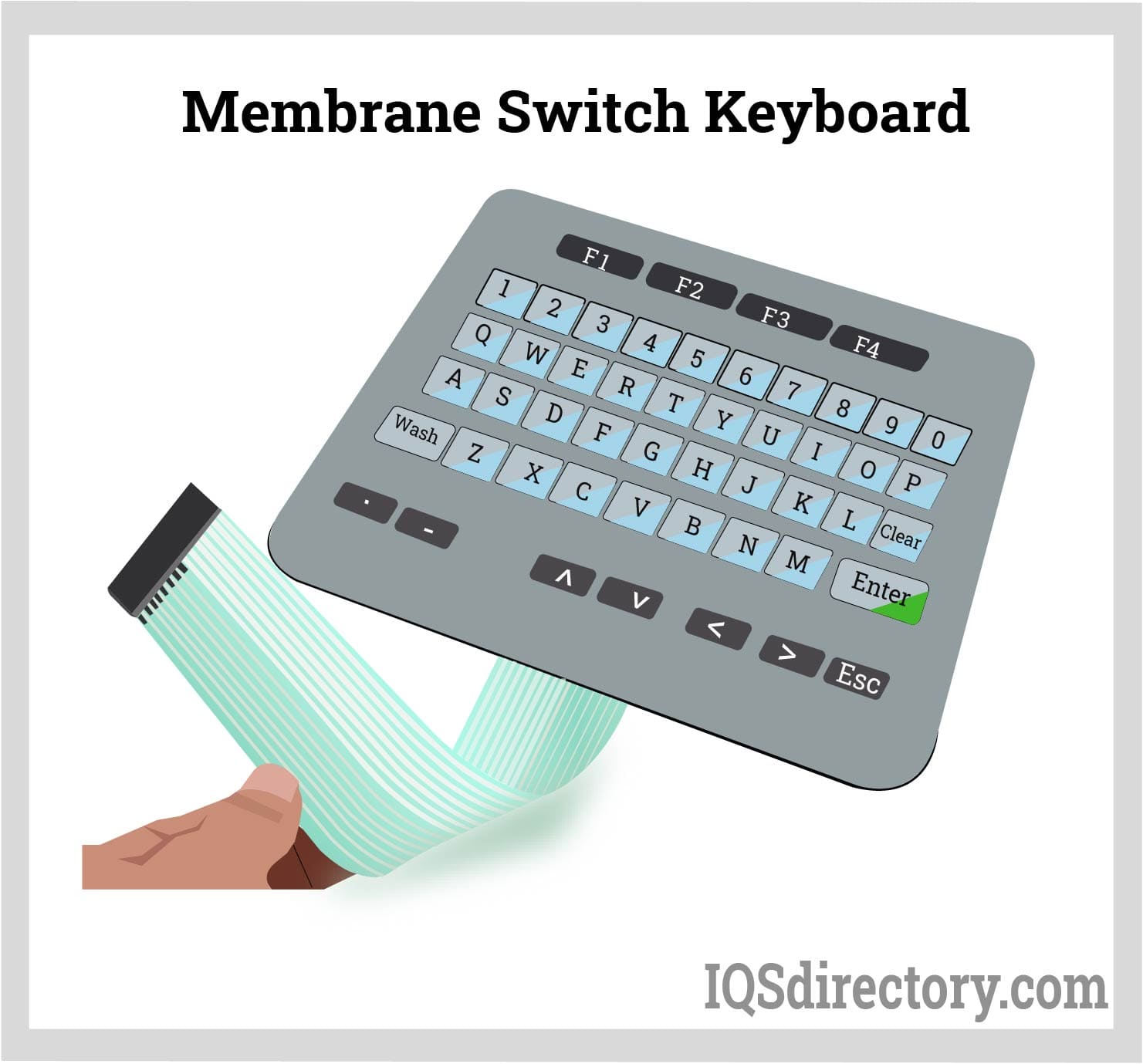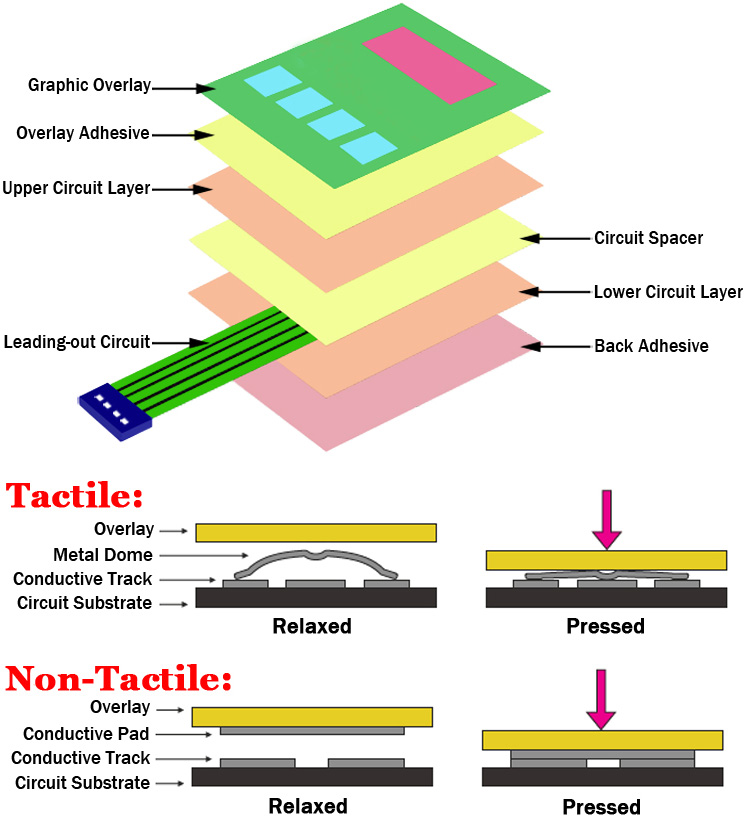How membrane switch is improving user interaction in medical devices
Everything About Membrane Switch Over: A Comprehensive Guide for Beginners
Membrane buttons are crucial elements in modern-day electronics, offering a distinct interface for customer communication - membrane switch. Their split building, including overlays and conductive traces, provides performance and longevity. Unlike conventional mechanical switches, membrane layer switches offer a sleek layout and personalized alternatives. Understanding their essential features and advantages can transform item design. The intricacies of their application and layout factors to consider require additional expedition.
What Is a Membrane layer Switch over?
A membrane switch is a sort of electric button that consists of an adaptable membrane layered over a printed motherboard. This style enables for a smooth and small user interface, typically used in various electronic tools. Membrane switches are typically found in consumer devices, medical equipment, and industrial machinery as a result of their toughness and resistance to environmental factors.The building and construction normally consists of multiple layers, such as visuals overlays and adhesive backing, which give responsive responses and protect the wiring underneath. The operation of a membrane switch is started when stress is related to the surface area, completing an electric circuit.These buttons are valued for their convenience, allowing personalized styles and published graphics that accommodate details interface. Their low-profile nature reduces space requirements, making them suitable for applications where conventional switches may not fit. Overall, membrane layer switches supply a functional and visual service for modern-day digital tools.
Key Components of Membrane Changes
Membrane layer changes consist of a number of vital components that add to their performance and efficiency. The top layer, referred to as the overlay, gives the interface and is usually printed with graphics or signs. Underneath the overlay exists a spacer layer, which separates the conductive elements and protects against inadvertent activation. The following essential component is the visuals layer, which improves visual appeals and assures the toughness of the design.Conductive traces, usually made from materials like silver or carbon, are printed on the circuit layer. When stress is put on the overlay, these traces come into contact, completing the circuit. Furthermore, a backing layer uses structural support and can be made from products such as polyester or polycarbonate. Together, these elements develop a trustworthy, straightforward user interface suitable for various applications, from family home appliances to commercial tools. Comprehending these aspects is important for anybody interested in membrane button modern technology.
How Membrane Layer Switches Job
Comprehending how membrane switches function is necessary for valuing their extensive usage in different devices. A membrane button runs via a collection of layers, consisting of a graphic overlay, spacer, and a circuit layer. When pressure is put on the overlay, it presses the spacer layer, permitting the circuit layer to make get in touch with and complete an electrical circuit. This action sends out a signal to the tool, triggering a response, such as switching on a light or turning on a function.Membrane changes can be created with different attributes, consisting of tactile feedback, backlighting, and custom-made graphics, boosting user interaction. Their building allows for a closed style, protecting the inner elements from dirt, moisture, and impurities. This durability makes them suitable for varied applications, from consumer electronics to commercial equipment. Generally, the simpleness and effectiveness of membrane changes add to their appeal in modern-day innovation.
Benefits of Membrane Switches Mechanical Switches
While mechanical buttons have actually long been a staple in numerous gadgets, membrane switches over offer distinct advantages that make them significantly appealing. One substantial benefit is their slim profile, enabling for even more portable styles and greater adaptability in item growth. Additionally, membrane layer switches over attribute a consistent surface, which improves visual charm and simplifies cleaning, making them ideal for settings where hygiene is critical.Another benefit is their resistance to dust and wetness. Unlike mechanical buttons, which can be endangered by ecological aspects, membrane layer buttons provide a sealed interface that protects versus contaminants - membrane switch. Membrane buttons normally have a longer life-span due to less moving components, resulting in boosted toughness and reliability.Cost-effectiveness is likewise a notable benefit, as membrane switches can be produced in bulk with lower manufacturing prices. These aspects integrate to place membrane buttons as a useful alternative to standard mechanical alternatives in different applications
Common Applications of Membrane Switches Over
Membrane switches are widely made use of in numerous fields, particularly in customer electronic devices and commercial control board. In customer gadgets, they supply a smooth, easy to use interface, while in industrial settings, they boost durability and capability. Understanding these applications highlights the convenience and practicality of membrane layer buttons in contemporary innovation.
Consumer Electronic Devices Instruments
As customer electronics remain to advance, membrane layer switches have actually come to be a preferred choice for a selection of devices due to their versatility and sleek design. These switches are generally discovered in smart devices, tablets, and push-button controls, where room is restricted and aesthetic appeals issue. Their low profile and customizable styles allow producers to produce user-friendly interfaces that enhance the total user experience. Furthermore, membrane buttons are frequently utilized in devices such as microwaves and coffee manufacturers, giving intuitive control choices while standing up to moisture and dust. The resilience and integrity of membrane switches make them ideal for daily consumer products, making certain long life and consistent performance. On the whole, their assimilation in consumer electronics reflects a mix of performance and modern layout.
Industrial Control Panels
The applications of membrane changes expand beyond customer electronics, finding significant use in commercial control board. These buttons are preferred for their longevity and resistance to harsh atmospheres, making them ideal for making and procedure control settings. They supply a dependable user interface for drivers to manage equipment, monitor processes, and adjust setups. Membrane layer switches can be tailored to fit details operational demands, including features like backlighting and tactile feedback, boosting customer experience. Their inconspicuous style permits combination into different equipment, while their capacity to endure spills, dirt, and extreme temperature levels warranties durability. Generally, membrane layer switches add to safe and efficient procedure in commercial applications, showing their adaptability and efficiency in requiring settings.
Factors To Consider for Designing Membrane Switches
When creating membrane buttons, picking the right products is necessary to assure longevity and performance. Furthermore, recognizing layer configuration strategies can significantly affect the switch's efficiency and user experience. These factors to consider play an important function in developing reputable and effective membrane layer switch designs.
Material Option Relevance
Material choice plays a crucial function in the layout and functionality of membrane layer switches. The chosen products directly try here influence the switch's toughness, responsive feedback, and overall aesthetic. Key factors to consider include the substratum, which must supply architectural honesty while allowing for versatility, and the graphic overlay, which requires to be resistant to use and environmental factors. Conductive materials need to ensure trusted electric efficiency, while adhesives must offer strong bonding without endangering the switch's operation. In addition, compatibility with producing procedures and end-user settings is vital; materials need to endure varying temperature levels, humidity degrees, and chemical exposure. Inevitably, suitable material option not just enhances the membrane button's performance however also contributes to its durability and user satisfaction, making it a vital aspect of the layout process.

Layer Arrangement Strategies

Often Asked Concerns
How Much Time Do Membrane Switches Over Usually Last?
Membrane layer buttons typically have a life expectancy of 1 to 5 million cycles, relying on use and ecological problems. Elements such as design quality and operating anchor frequency substantially affect their toughness and total performance durability.

Can Membrane Changes Be Customized for Specific Layouts?
Membrane layer switches can certainly be customized to suit certain layouts, permitting diverse forms, colors, and functionalities. This convenience enables makers to tailor these switches to fulfill one-of-a-kind visual and functional needs effectively.
What Materials Are Made Use Of in Membrane Switch Construction?
Membrane switches are commonly created utilizing products such as polyester, polycarbonate, you could check here and sticky layers. These products supply versatility, resistance, and toughness to ecological aspects, ensuring the switches function effectively in various applications and conditions.
Are Membrane Switches Resistant or water-proof to Moisture?
Membrane buttons can be created to be moisture-resistant, making use of specialized finishes and products. Their waterproof capacities depend on construction quality and specific applications, making it important to analyze needs for optimal performance in different atmospheres.
Exactly How Are Membrane Changes Fixed if Damaged?
Fixing broken membrane layer switches usually entails replacing the influenced layer or circuit. Technicians might additionally use conductive glue or utilize specialized repair work sets, guaranteeing performance is brought back without total substitute of the whole switch setting up. Unlike typical mechanical buttons, membrane layer buttons present a streamlined layout and personalized alternatives. A membrane layer switch is a type of electric switch that is composed of an adaptable membrane layer layered over a published circuit board. The operation of a membrane button is initiated when pressure is used to the surface area, finishing an electrical circuit.These buttons are valued for their versatility, making it possible for personalized styles and printed graphics that cater to particular individual interfaces. While mechanical buttons have long been a staple in several devices, membrane layer switches over offer distinctive benefits that make them progressively appealing. Membrane buttons typically have a longer life expectancy due to fewer moving parts, resulting in boosted durability and reliability.Cost-effectiveness is likewise a noteworthy advantage, as membrane buttons can be produced in bulk with lower production costs.